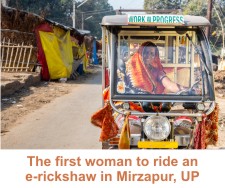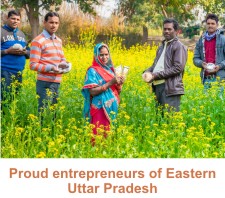Tracking SDGs In Enterprise Development Programmes
Entrepreneurship
as an option
What is the first thing you did after college? Job applications I am
guessing? Probably after 3 months you scored a job but some of your college
friends are still unemployed. After your friend comes out of a torturous
interview process, you take her for tea to 'Ramu's chai and momo corner'.
You ask Ramu how much he makes per day and realise he makes more than you.
Ramu does not have the right resume, but he has the business acumen, the
right equipment and occupies the busiest spot on the street.
The increasing gap between the demand and supply for jobs can be filled if the world has more Ramus. Why was starting your own enterprise a far-fetched option for you after college? Probably because you did not have the 'right' idea or because everyone around you was always talking about getting in the top five organisations instead of starting their own. Maybe if you grew up in an environment that encouraged entrepreneurship and your college had enterprise support service fairs in addition to career fairs, you would have become an entrepreneur.
In rural India, the absence of opportunities to become entrepreneurs is even more acute. The residents of rural India often remain under employed or unemployed even though the scope of setting up micro enterprises such as general stores and water supply plants is high considering residents of most villages often have to travel miles to get basic utilities.
W4P and the SDGs
The Work 4 Progress (W4P) programme of ”la Caixa” Banking Foundation creates opportunities for entrepreneurship by building a supportive ecosystem along with unleashing the entrepreneurial energies of individuals. Ultimately, it aims to create sustainable enterprises that flourish in an ecosystem which has a culture supportive of enterprise and entrepreneurship, the existence of adequate enterprise support services and mechanisms that promote economic and social inclusion.
The most apparent relationship between enterprise development and the 2030 Agenda can be found in SDG target 8.3 which underlines the importance of enterprises and entrepreneurship in relation to productive activities, decent job creation and stresses the need to encourage formalisation and growth of micro, small and medium sized enterprises.
Apart from creating jobs like most traditional development models, the programme necessitates a move away from direct funding towards an approach of empowering and enabling communities to ‘help themselves’. This move is crucial for achieving the SDGs.
Social enterprises such as the Community Owned and Community Operated (COCO)
safe water supply is one such model which has enabled communities to become
self- reliant. In a village like Madore in the drought prone Bundelkhand
region of Central India, where water scarcity has always been a problem, the
model has equipped communities to find a long term solution to the problem
through a collective fund managed by the village committee.

In order to understand and provide support in overcoming various individual inhibitions, W4P has engaged in deep and continuous dialogue with the communities. The nature of this dialogue has been a major factor that has led to set up enterprises by women and youth - two sections of the society that generally choose options other than entrepreneurship for income generation. In rural India, it is unconventional for a woman to start an e-rickshaw or electronic repair enterprise. If you go to Mirzapur in Uttar Pradesh today, you will spot Pragya Devi or Bhagwani Devi riding around in their e-rickshaws and you might even get a ride if you are lucky enough to get a spot. In parts of Bundlekhand, where youth usually mock the peer who sets up an enterprise instead of working as a labourer, a few youth entrepreneurs have come up. Some like Narendra, the owner of New Fashion Lucky Tailor describe how they never wanted to become farmers in Bundelkhand as the time investment did not give equal monetary returns.
A major part of the foundation of W4P lies in jointly building sustainable
communities that brings together relevant stakeholders through a common and
neutral platform to jointly analyse, discuss and act on building a culture
of entrepreneurship in the entire ecosystem. One way in which this has been
done is through the regional stakeholder meetings between various local and
national service providers, entrepreneurs and experts in the field. Over the
past one year, the coalition has led to the convergence of interests and
resources of its participants. This can most evidently be seen from the
increasingly liberal approach of micro-finance institutions towards
servicing micro entrepreneurs in some programme geographies. One micro
finance institution has even amended its by-laws for making repayment an
easier process for micro entrepreneurs.
brings together relevant stakeholders through a common and
neutral platform to jointly analyse, discuss and act on building a culture
of entrepreneurship in the entire ecosystem. One way in which this has been
done is through the regional stakeholder meetings between various local and
national service providers, entrepreneurs and experts in the field. Over the
past one year, the coalition has led to the convergence of interests and
resources of its participants. This can most evidently be seen from the
increasingly liberal approach of micro-finance institutions towards
servicing micro entrepreneurs in some programme geographies. One micro
finance institution has even amended its by-laws for making repayment an
easier process for micro entrepreneurs.
Apart from finance, the coalition has also led to an increase in the interest of training institutes, technology providers and market aggregators. With proper training and links to technology, entrepreneurs are able to participate in the competitive economy. Asha Devi, started her vermicomposting enterprise after attending a training programme and getting access to the latest equipment. The demand for her products increased double fold over four months and she now procures from other vermicompost manufacturers to meet this increase in demand.
The inception of a culture of entrepreneurship in rural communities can be evidenced from the dozen enterprises that have come up through peer-to-peer learning in some programme geographies.
Conclusion
In order to bridge the current employment gap, India will need to create decent work opportunities for 15 million people; each year, for the next 15 years. Micro enterprises employ close to 40% of India's workforce. Any impetus to this sector will bridge the employment gap. Over the past two years, W4P has created 175 enterprises and 422 jobs in two geographies of Eastern UP and Bundelkhand. Out of 175, one-third are women entrepreneurs, around 45% are youth entrepreneurs and around 50% are new entrepreneurs. The programme aims to create 1000 enterprises and 2500 jobs.
Over the past three years, all of us have become familiar with the seventeen sustainable development goals (SDGs).These goals are inter-dependent and perhaps indivisible. For instance, enterprise development addresses multiple goals simultaneously. It can lead to a reduction in poverty through an increase in financial performance, or greater participation of women and youth in the productive economy. It can also lead to greater participation in the competitive markets with increase in access to innovation and finance or enterprise development through relevant training. It can also build sustainable communities by creating partnerships through platforms such as the regional coalition and social enterprises such as COCO can even increase access to basic needs.
Multiple links can be formed between enterprise development and the goals but the key to making them 'sustainable' is enabling the individuals, communities and the ecosystem. ■
Stuti Sareen
ssareen@devalt.org